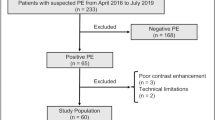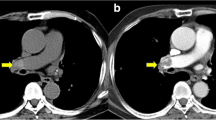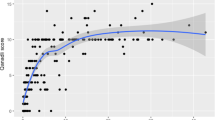Abstract
Purpose
The aim of this study was to determine whether pulmonary embolus volume (PEV) obtained with multi-detector row computed tomography is related to clinical status and outcomes.
Materials and methods
Subjects comprised 48 patients with acute pulmonary embolism (PTE). PEV was measured by tracing the contours manually and compared between sets of two groups divided by clinical status. Correlations of PEV to blood gases and D-dimer levels were investigated. PEV was tested as a predictor of clinical probability of acute PTE using Wells’ criteria and as a predictor of survival after PTE by logistic regression analysis.
Results
The PEV was greater in groups with respiratory symptoms (P < 0.001), PTE as pretest clinical diagnosis (P = 0.027), and heart rate >100 beats/min (P < 0.001). It was smaller in subjects with concurrent malignancy (P = 0.02). It was correlated with PaCO2 (P = 0.04, ρ = −0.37) and the D-dimer level (P = 0.002, ρ = 0.46); it was not a predictor of clinical probability of acute PTE or survival after PTE. The survival rate did not differ between groups with PEV > 10 ml (8/9) or ≤10 ml (32/36).
Conclusion
The PEV in acute PTE may relate to the presence of respiratory symptoms, hypocapnia, and tachycardia. The PEV was smaller in patients with malignancy. It did not contribute to mortality in this study.
Similar content being viewed by others
References
Stein PD, Fowler SE, Goodman LR, Gottschalk A, Hales CA, Hull RD, et al. Multidetector computed tomography for acute pulmonary embolism. N Engl J Med 2006;354:2317–2327.
Anderson DR, Kahn SR, Rodger MA, Kovacs MJ, Morris T, Hirsch A, et al. Computed tomographic pulmonary angiography vs ventilation-perfusion lung scanning in patients with suspected pulmonary embolism: a randomized controlled trial. JAMA 2007;298:2743–2753.
Miller GA, Sutton GC, Kerr IH, Gibson RV, Honey M. Comparison of streptokinase and heparin in treatment of isolated acute massive pulmonary embolism. BMJ 1971;19:681–684.
Qanadli SD, El Hajjam M, Vieillard-Baron A, Joseph T, Mesurolle B, Oliva VL, et al. New CT index to quantify arterial obstruction in pulmonary embolism: comparison with angiographic index and echocardiography. AJR Am J Roentgenol 2001;176:1415–1420.
Wu AS, Pezzullo JA, Cronan JJ, Hou DD, Mayo-Smith WW. CT pulmonary angiography: quantification of pulmonary embolus as a predictor of patient outcome—initial experience. Radiology 2004;230:831–835.
Pech M, Wieners G, Dul P, Fischbach F, Dudeck O, Lopez Hänninen E, et al. Computed tomography pulmonary embolism index for the assessment of survival in patients with pulmonary embolism. Eur Radiol 2007;17:1954–1959.
Storto ML, Di Credico A, Guido F, Larici AR, Bonomo L. Incidental detection of pulmonary emboli on routine MDCT of the chest. AJR Am J Roentgenol 2005;184:264–267.
Wells PS, Anderson DR, Rodger M, Ginsberg JS, Kearon C, Gent M, et al. Derivation of a simple clinical model to categorize patients probability of pulmonary embolism: increasing the models utility with the simpleRED D-dimer. Thromb Haemost 2000;83:416–420.
Bankier AA, Janata K, Fleischmann D, Kreuzer S, Mallek R, Frossard M, et al. Severity assessment of acute pulmonary embolism with spiral CT: evaluation of two modified angiographic scores and comparison with clinical data. J Thorac Imaging 1997;12:150–158.
Mastora I, Remy-Jardin M, Masson P, Galland E, Delannoy V, Bauchart JJ, et al. Severity of acute pulmonary embolism: evaluation of a new spiral CT angiographic score in correlation with echocardiographic data. Eur Radiol 2003;13:29–35.
Gladish GW, Choe DH, Marom EM, Sabloff BS, Broemeling LD, Munden RF. Incidental pulmonary emboli in oncology patients: prevalence, CT evaluation, and natural history. Radiology 2006;240:246–255.
Sebastian AJ, Paddon AJ. Clinically unsuspected pulmonary embolism: an important secondary finding in oncology CT. Clin Radiol 2006;61:81–85.
Boswell WD, Peierce J, Fahimi A, Parisky Y, Sheth P. Incidental pulmonary emboli detected by multi-detector row spiral CT in cancer patients. Cancer Imaging 2004;4:S58.
Meignan M, Rosso J, Gauthier H, Brunengo F, Claudel S, Sagnard L, et al. Systematic lung scans reveal a high frequency of silent pulmonary embolism in patients with proximal deep venous thrombosis. Arch Intern Med 2000;160:159–164.
Miyahara Y, Ikeda S, Kohno S. Incidence and prognosis of pulmonary embolism in Japan. ICU CCU 2004;28:147–150 (in Japanese).
Metafratzi ZM, Vassiliou MP, Maglaras GC, Katzioti FG, Constantopoulos SH, Katsaraki A, et al. Acute pulmonary embolism: correlation of CT pulmonary artery obstruction index with blood gas values. AJR Am J Roentgenol 2006;186:213–219.
Gosselin MV, Rubin GD, Leung AN, Huang J, Rizk NW. Unsuspected pulmonary embolism: prospective detection on routine helical CT scans. Radiology 1998;208:209–215.
Author information
Authors and Affiliations
Corresponding author
About this article
Cite this article
Nakada, K., Okada, T., Osada, H. et al. Relation between pulmonary embolus volume quantified by multidetector computed tomography and clinical status and outcome for patients with acute pulmonary embolism. Jpn J Radiol 28, 34–42 (2010). https://doi.org/10.1007/s11604-009-0380-x
Received:
Accepted:
Published:
Issue Date:
DOI: https://doi.org/10.1007/s11604-009-0380-x




